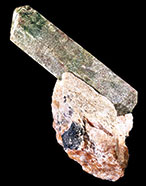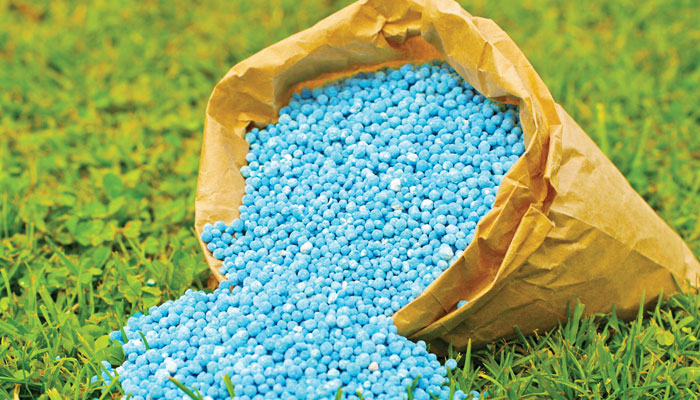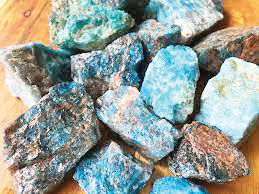
For the growth and survival of life, where other mineral components are needed from a “medical” point of view, the “phosphorus” component also has an important place, which is abundant in the mineral “Apatite”. ) is derived from In the ancient times, phosphorus was only used in the production of flame “spark” matches or other flammable materials, which is still going on, but after the industrial revolution, when the veil was lifted from the hidden fact that the composition of this mineral contains a significant amount of phosphorus. exists and on this basis it can be used in soil fertilization and dental industry, its importance has doubled in modern times.
The mineral “apatite” is derived from the Greek word Apatao, which means to deceive. The reason for this was that in the early period, this mineral was similar to other gems such as beryl due to pen features, which led to the assumption that it was related to a gemstone during the field survey. The reality was quite the opposite, because it is a mineral of a completely different nature from the gemstone. This was confirmed when geologists gave it a distinct identity as a “phosphorite” sedimentary deposit based on chemical tests.
Phosphorite deposits are actually a mixture of phosphorus mineral components, in which the most important mineral is apatite, which has a large proportion of calcium phosphate in its composition, which is the main source of phosphorus. With the passage of time, its economic importance became known around the world, especially in “Morocco” (Morocco). In the form of excrement of birds and bats, these minerals became concentrated and this mineral is 0.1% in normal sedimentary rock environment while phosphate is present in sedimentary rock environment up to 37% of phosphate.

Because bones are made of calcium phosphate. This is the reason why phosphate or phosphorus is produced in areas that are suitable for the production of species, which is the photozone of the ocean. This is the part of the global ocean where the upper 200m shows the best productivity. In particular, the upper 60-80 m depth is the accumulation zone, where the complex food chain for the initial nomenclature begins and it continues the productivity under the high supply process through the water cycle (upwelling), which It contains a lot of nutrients, due to which the productivity of phosphate increases significantly.
It is now well established that phosphate formation occurs in areas where there is strong upwelling and where productivity is high (photozone). For example, it has been found on the edges of the continental slope of Chile and Peru. Upwelling of water takes place from great depths, carrying with it large amounts of nutrients, which occurs due to the efficiency of advection and dissolution.
Uplift of water and nutrient supply is also high in areas where large and many rivers join the sea and where erosion continues day and night. This is because up to 90% of productivity is increased by the waste accumulation of microscopic unicellular species in oceans and rivers, such as plant swimming (diatoms) and animal swimming (radioserine).
But at the same time, the mortality rate also increases due to which the ecosystem of the sea remains balanced, but three types of situations arise, i.e., some other large mammals eat it, and some body parts start to sink to the bottom. Before they accumulate on the sea floor, they dissolve and release phosphates and other nutrients into the water, or the sediments are formed into nodules by the Traction Current waves from the deep sea and become camalgo merit. (sedimentary rock) This process takes place in the continental shelf at a depth of 100-400m but below the “photozone”.
Practically all apatite deposits are of marine nature, but some specific types of deposits are also formed in dry (continental) environment, guano deposits. and formed by the accumulation of bat droppings. Especially in desert coastal areas where limestone is composed of other calcium-bearing rocks. Fish-eating birds and bats burrow into rock cavities for phosphorus and other nutrients. They are based on exclusion and accumulation layer by layer.

Because guanosine and limestone are acidic in nature, they react to form phosphatic minerals. For example, apatite, some calcium carbonate migrates by dissolving into bicarbonate. While the rest of the calcium component is bound to phosphorus. Thus phosphorus oxide is produced which is the mineral apatite. That is why these reservoirs are protected when the rainfall in the region is very high.
If there is heavy and heavy rain, the phosphates in the guano deposits will be dispersed on the land side and eventually the area will be only clay. According to the 2007 survey, the proportion of nitrogen and phosphorus and the proportion of carbon and phosphorus in the composition of these wastes have been found to be high. Bird’s guano deposits contain high levels of nutrients such as nitrate and ammonia (2-8% by weight), nitrogen, 80% uric acid, 10% protein, 7% ammonia and 0.5% nitrate, some of the guano. Very common chemical elements found in waste. They contain significant amounts of phosphorus, calcium, and magnesium. Bat droppings were found to contain the exoskeleton of insect shells, which are mostly chitin in nature.
The elements in it are nitrogen, sulfur and phosphorus. Because “epanite” formed from guano deposits contains large amounts of nitrogen, phosphorus and potassium which are essential for the growth of plant life. For this reason, 90% of it is mixed with soil in agriculture and used for agricultural purposes. It happens, because the tooth, whether human or animal, consists of calcium phosphate (apatite), which has a hardness of 5 on the Mahs hardness scale, and the hardness of the tooth is also about 5. That’s why. It is preferred in dentistry, as no other composition and hardness components can be accepted by the tooth.

Large deposits of apatite were discovered in the north-south basin of Ukraine in the 19th century, where phosphorite was discovered in the outer Upper Cretaceous sediments of Podolia, western Ukraine, on the Volga coast of Saratov. Its northern boundary is in the Kurask region, while the southern boundary deposits of the Donets basin are found in a mixed state with sands that exist in nodals or thin layer health. .
In addition, considerable attention was paid to the discovery of mineral resources on a global scale between 1889-1945, which resulted in the discovery of apatite deposits in several riverine countries, including apatite in the Kara-Tau mountain ranges. A high-grade economic deposit was discovered, which was confirmed by laboratory chemical tests to determine whether it contained apatite ore, for which the first sample obtained was Dissolved in high boiling Naizic Acid. After that, a few drops of this dissolved solution should be added to the “Ammonium Molybdate” solution. If a light yellow color mixture appears, then surely phosphorus is present.
setTimeout(function(){
!function(f,b,e,v,n,t,s)
{if(f.fbq)return;n=f.fbq=function(){n.callMethod?
n.callMethod.apply(n,arguments):n.queue.push(arguments)};
if(!f._fbq)f._fbq=n;n.push=n;n.loaded=!0;n.version=’2.0′;
n.queue=[];t=b.createElement(e);t.async=!0;
t.src=v;s=b.getElementsByTagName(e)[0];
s.parentNode.insertBefore(t,s)}(window,document,’script’,
‘https://connect.facebook.net/en_US/fbevents.js’);
fbq(‘init’, ‘836181349842357’);
fbq(‘track’, ‘PageView’);
}, 6000);
/*setTimeout(function(){
(function (d, s, id) {
var js, fjs = d.getElementsByTagName(s)[0];
if (d.getElementById(id)) return;
js = d.createElement(s);
js.id = id;
js.src = “//connect.facebook.net/en_US/sdk.js#xfbml=1&version=v2.11&appId=580305968816694”;
fjs.parentNode.insertBefore(js, fjs);
}(document, ‘script’, ‘facebook-jssdk’));
}, 4000);*/



